Xun Yang
End-to-End Humanoid Robot Safe and Comfortable Locomotion Policy
Aug 11, 2025Abstract:The deployment of humanoid robots in unstructured, human-centric environments requires navigation capabilities that extend beyond simple locomotion to include robust perception, provable safety, and socially aware behavior. Current reinforcement learning approaches are often limited by blind controllers that lack environmental awareness or by vision-based systems that fail to perceive complex 3D obstacles. In this work, we present an end-to-end locomotion policy that directly maps raw, spatio-temporal LiDAR point clouds to motor commands, enabling robust navigation in cluttered dynamic scenes. We formulate the control problem as a Constrained Markov Decision Process (CMDP) to formally separate safety from task objectives. Our key contribution is a novel methodology that translates the principles of Control Barrier Functions (CBFs) into costs within the CMDP, allowing a model-free Penalized Proximal Policy Optimization (P3O) to enforce safety constraints during training. Furthermore, we introduce a set of comfort-oriented rewards, grounded in human-robot interaction research, to promote motions that are smooth, predictable, and less intrusive. We demonstrate the efficacy of our framework through a successful sim-to-real transfer to a physical humanoid robot, which exhibits agile and safe navigation around both static and dynamic 3D obstacles.
Adversarially Robust AI-Generated Image Detection for Free: An Information Theoretic Perspective
May 28, 2025Abstract:Rapid advances in Artificial Intelligence Generated Images (AIGI) have facilitated malicious use, such as forgery and misinformation. Therefore, numerous methods have been proposed to detect fake images. Although such detectors have been proven to be universally vulnerable to adversarial attacks, defenses in this field are scarce. In this paper, we first identify that adversarial training (AT), widely regarded as the most effective defense, suffers from performance collapse in AIGI detection. Through an information-theoretic lens, we further attribute the cause of collapse to feature entanglement, which disrupts the preservation of feature-label mutual information. Instead, standard detectors show clear feature separation. Motivated by this difference, we propose Training-free Robust Detection via Information-theoretic Measures (TRIM), the first training-free adversarial defense for AIGI detection. TRIM builds on standard detectors and quantifies feature shifts using prediction entropy and KL divergence. Extensive experiments across multiple datasets and attacks validate the superiority of our TRIM, e.g., outperforming the state-of-the-art defense by 33.88% (28.91%) on ProGAN (GenImage), while well maintaining original accuracy.
Omni-Perception: Omnidirectional Collision Avoidance for Legged Locomotion in Dynamic Environments
May 25, 2025Abstract:Agile locomotion in complex 3D environments requires robust spatial awareness to safely avoid diverse obstacles such as aerial clutter, uneven terrain, and dynamic agents. Depth-based perception approaches often struggle with sensor noise, lighting variability, computational overhead from intermediate representations (e.g., elevation maps), and difficulties with non-planar obstacles, limiting performance in unstructured environments. In contrast, direct integration of LiDAR sensing into end-to-end learning for legged locomotion remains underexplored. We propose Omni-Perception, an end-to-end locomotion policy that achieves 3D spatial awareness and omnidirectional collision avoidance by directly processing raw LiDAR point clouds. At its core is PD-RiskNet (Proximal-Distal Risk-Aware Hierarchical Network), a novel perception module that interprets spatio-temporal LiDAR data for environmental risk assessment. To facilitate efficient policy learning, we develop a high-fidelity LiDAR simulation toolkit with realistic noise modeling and fast raycasting, compatible with platforms such as Isaac Gym, Genesis, and MuJoCo, enabling scalable training and effective sim-to-real transfer. Learning reactive control policies directly from raw LiDAR data enables the robot to navigate complex environments with static and dynamic obstacles more robustly than approaches relying on intermediate maps or limited sensing. We validate Omni-Perception through real-world experiments and extensive simulation, demonstrating strong omnidirectional avoidance capabilities and superior locomotion performance in highly dynamic environments. We will open-source our code and models.
AlphaFuse: Learn ID Embeddings for Sequential Recommendation in Null Space of Language Embeddings
Apr 29, 2025


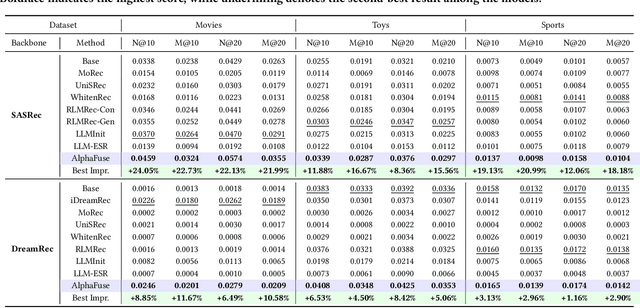
Abstract:Recent advancements in sequential recommendation have underscored the potential of Large Language Models (LLMs) for enhancing item embeddings. However, existing approaches face three key limitations: 1) the degradation of the semantic space when high-dimensional language embeddings are mapped to lower-dimensional ID embeddings, 2) the underutilization of language embeddings, and 3) the reliance on additional trainable parameters, such as an adapter, to bridge the gap between the semantic and behavior spaces. In this paper, we introduce AlphaFuse, a simple but effective language-guided learning strategy that addresses these challenges by learning ID embeddings within the null space of language embeddings. Specifically, we decompose the semantic space of language embeddings via Singular Value Decomposition (SVD), distinguishing it into a semantic-rich row space and a semantic-sparse null space. Collaborative signals are then injected into the null space, while preserving the rich semantics of the row space. AlphaFuse prevents degradation of the semantic space, integrates the retained language embeddings into the final item embeddings, and eliminates the need for auxiliary trainable modules, enabling seamless adaptation to any sequential recommendation framework. We validate the effectiveness and flexibility of AlphaFuse through extensive experiments on three benchmark datasets, including cold-start user and long-tail settings, showcasing significant improvements in both discriminative and diffusion-based generative sequential recommenders. Our codes and datasets are available at https://github.com/Hugo-Chinn/AlphaFuse.
Structure-guided Diffusion Transformer for Low-Light Image Enhancement
Apr 21, 2025Abstract:While the diffusion transformer (DiT) has become a focal point of interest in recent years, its application in low-light image enhancement remains a blank area for exploration. Current methods recover the details from low-light images while inevitably amplifying the noise in images, resulting in poor visual quality. In this paper, we firstly introduce DiT into the low-light enhancement task and design a novel Structure-guided Diffusion Transformer based Low-light image enhancement (SDTL) framework. We compress the feature through wavelet transform to improve the inference efficiency of the model and capture the multi-directional frequency band. Then we propose a Structure Enhancement Module (SEM) that uses structural prior to enhance the texture and leverages an adaptive fusion strategy to achieve more accurate enhancement effect. In Addition, we propose a Structure-guided Attention Block (SAB) to pay more attention to texture-riched tokens and avoid interference from noisy areas in noise prediction. Extensive qualitative and quantitative experiments demonstrate that our method achieves SOTA performance on several popular datasets, validating the effectiveness of SDTL in improving image quality and the potential of DiT in low-light enhancement tasks.
Towards Efficient Partially Relevant Video Retrieval with Active Moment Discovering
Apr 15, 2025



Abstract:Partially relevant video retrieval (PRVR) is a practical yet challenging task in text-to-video retrieval, where videos are untrimmed and contain much background content. The pursuit here is of both effective and efficient solutions to capture the partial correspondence between text queries and untrimmed videos. Existing PRVR methods, which typically focus on modeling multi-scale clip representations, however, suffer from content independence and information redundancy, impairing retrieval performance. To overcome these limitations, we propose a simple yet effective approach with active moment discovering (AMDNet). We are committed to discovering video moments that are semantically consistent with their queries. By using learnable span anchors to capture distinct moments and applying masked multi-moment attention to emphasize salient moments while suppressing redundant backgrounds, we achieve more compact and informative video representations. To further enhance moment modeling, we introduce a moment diversity loss to encourage different moments of distinct regions and a moment relevance loss to promote semantically query-relevant moments, which cooperate with a partially relevant retrieval loss for end-to-end optimization. Extensive experiments on two large-scale video datasets (\ie, TVR and ActivityNet Captions) demonstrate the superiority and efficiency of our AMDNet. In particular, AMDNet is about 15.5 times smaller (\#parameters) while 6.0 points higher (SumR) than the up-to-date method GMMFormer on TVR.
A Survey on fMRI-based Brain Decoding for Reconstructing Multimodal Stimuli
Mar 20, 2025
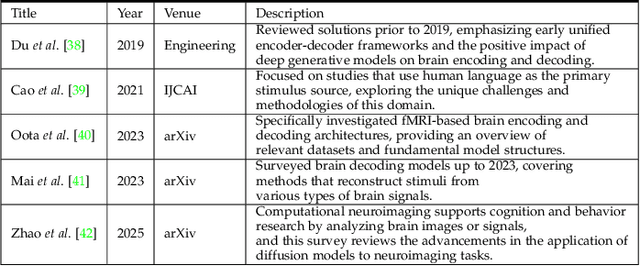
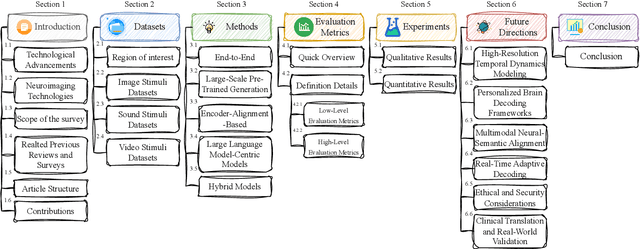
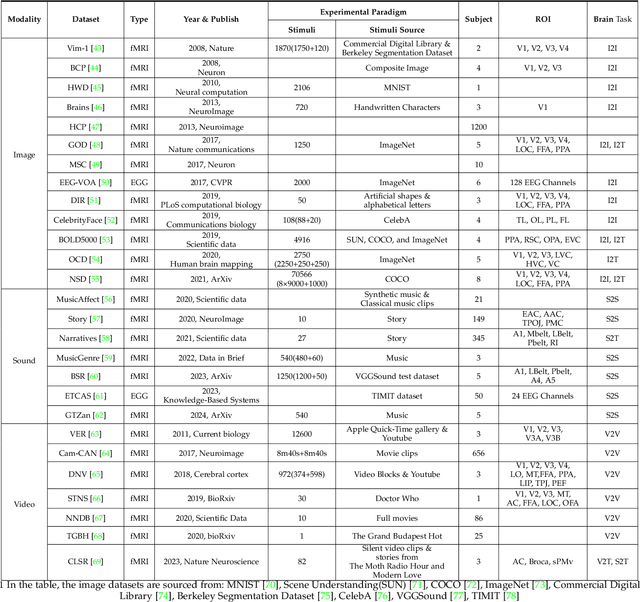
Abstract:In daily life, we encounter diverse external stimuli, such as images, sounds, and videos. As research in multimodal stimuli and neuroscience advances, fMRI-based brain decoding has become a key tool for understanding brain perception and its complex cognitive processes. Decoding brain signals to reconstruct stimuli not only reveals intricate neural mechanisms but also drives progress in AI, disease treatment, and brain-computer interfaces. Recent advancements in neuroimaging and image generation models have significantly improved fMRI-based decoding. While fMRI offers high spatial resolution for precise brain activity mapping, its low temporal resolution and signal noise pose challenges. Meanwhile, techniques like GANs, VAEs, and Diffusion Models have enhanced reconstructed image quality, and multimodal pre-trained models have boosted cross-modal decoding tasks. This survey systematically reviews recent progress in fMRI-based brain decoding, focusing on stimulus reconstruction from passive brain signals. It summarizes datasets, relevant brain regions, and categorizes existing methods by model structure. Additionally, it evaluates model performance and discusses their effectiveness. Finally, it identifies key challenges and proposes future research directions, offering valuable insights for the field. For more information and resources related to this survey, visit https://github.com/LpyNow/BrainDecodingImage.
EgoBlind: Towards Egocentric Visual Assistance for the Blind People
Mar 11, 2025Abstract:We present EgoBlind, the first egocentric VideoQA dataset collected from blind individuals to evaluate the assistive capabilities of contemporary multimodal large language models (MLLMs). EgoBlind comprises 1,210 videos that record the daily lives of real blind users from a first-person perspective. It also features 4,927 questions directly posed or generated and verified by blind individuals to reflect their needs for visual assistance under various scenarios. We provide each question with an average of 3 reference answers to alleviate subjective evaluation. Using EgoBlind, we comprehensively evaluate 15 leading MLLMs and find that all models struggle, with the best performers achieving accuracy around 56\%, far behind human performance of 87.4\%. To guide future advancements, we identify and summarize major limitations of existing MLLMs in egocentric visual assistance for the blind and provide heuristic suggestions for improvement. With these efforts, we hope EgoBlind can serve as a valuable foundation for developing more effective AI assistants to enhance the independence of the blind individuals' lives.
CMMLoc: Advancing Text-to-PointCloud Localization with Cauchy-Mixture-Model Based Framework
Mar 05, 2025



Abstract:The goal of point cloud localization based on linguistic description is to identify a 3D position using textual description in large urban environments, which has potential applications in various fields, such as determining the location for vehicle pickup or goods delivery. Ideally, for a textual description and its corresponding 3D location, the objects around the 3D location should be fully described in the text description. However, in practical scenarios, e.g., vehicle pickup, passengers usually describe only the part of the most significant and nearby surroundings instead of the entire environment. In response to this $\textbf{partially relevant}$ challenge, we propose $\textbf{CMMLoc}$, an uncertainty-aware $\textbf{C}$auchy-$\textbf{M}$ixture-$\textbf{M}$odel ($\textbf{CMM}$) based framework for text-to-point-cloud $\textbf{Loc}$alization. To model the uncertain semantic relations between text and point cloud, we integrate CMM constraints as a prior during the interaction between the two modalities. We further design a spatial consolidation scheme to enable adaptive aggregation of different 3D objects with varying receptive fields. To achieve precise localization, we propose a cardinal direction integration module alongside a modality pre-alignment strategy, helping capture the spatial relationships among objects and bringing the 3D objects closer to the text modality. Comprehensive experiments validate that CMMLoc outperforms existing methods, achieving state-of-the-art results on the KITTI360Pose dataset. Codes are available in this GitHub repository https://github.com/kevin301342/CMMLoc.
Precise Localization of Memories: A Fine-grained Neuron-level Knowledge Editing Technique for LLMs
Mar 03, 2025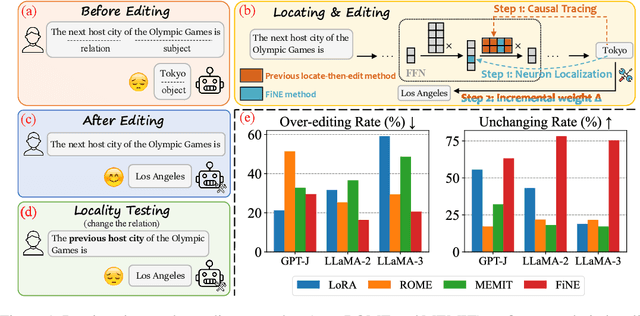
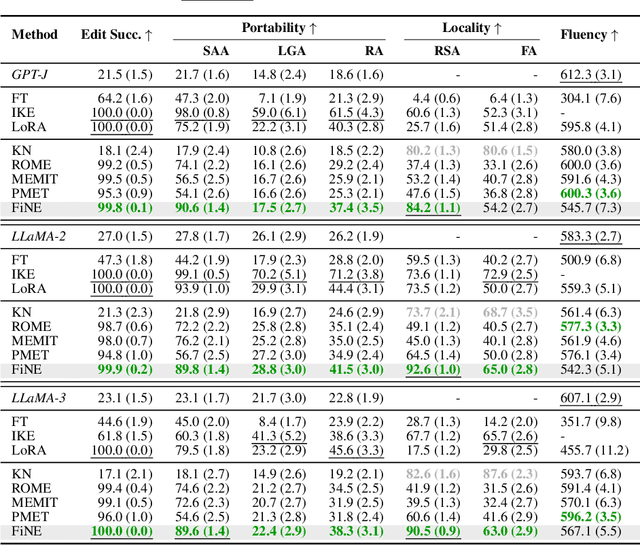
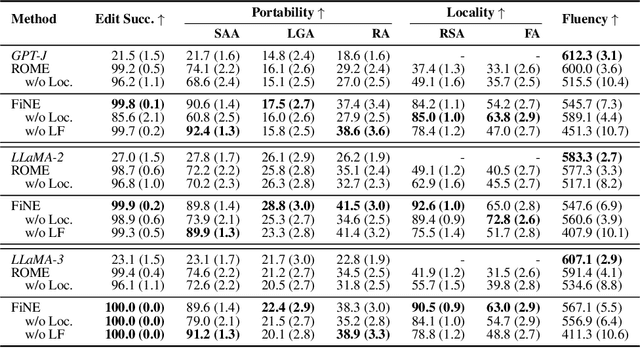

Abstract:Knowledge editing aims to update outdated information in Large Language Models (LLMs). A representative line of study is locate-then-edit methods, which typically employ causal tracing to identify the modules responsible for recalling factual knowledge about entities. However, we find these methods are often sensitive only to changes in the subject entity, leaving them less effective at adapting to changes in relations. This limitation results in poor editing locality, which can lead to the persistence of irrelevant or inaccurate facts, ultimately compromising the reliability of LLMs. We believe this issue arises from the insufficient precision of knowledge localization. To address this, we propose a Fine-grained Neuron-level Knowledge Editing (FiNE) method that enhances editing locality without affecting overall success rates. By precisely identifying and modifying specific neurons within feed-forward networks, FiNE significantly improves knowledge localization and editing. Quantitative experiments demonstrate that FiNE efficiently achieves better overall performance compared to existing techniques, providing new insights into the localization and modification of knowledge within LLMs.
 Add to Chrome
Add to Chrome Add to Firefox
Add to Firefox Add to Edge
Add to Edge